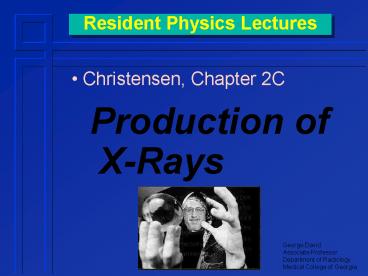Resident Physics Lectures - PowerPoint PPT Presentation
1 / 20
Title:
Resident Physics Lectures
Description:
Resident Physics Lectures Christensen, Chapter 2C Production of X-Rays George David Associate Professor Department of Radiology Medical College of Georgia – PowerPoint PPT presentation
Number of Views:257
Avg rating:3.0/5.0
Title: Resident Physics Lectures
1
Resident Physics Lectures
- Christensen, Chapter 2C
- Production of X-Rays
George David Associate Professor Department of
Radiology Medical College of Georgia
2
The Atomic Nucleus
- Protons
- Charges
- protons atomic (Z)
- Neutrons
- No charge
- Mass about the same as proton
- Atomic Weight(mass) protons neutrons
3
kVp kilovolts peak
- peak kilovoltage applied across x-ray tube
- voltage applied across x-ray tube pulses and
varies - single phase
- three phase
kVp
kVp
4
keV kilo-electron volt
- energy of an electron
- Kinetic energy
- Higher energy electron moves faster
- Electrons can be manipulated by electric fields
- Accelerated
- Steered
5
Orbital Electrons
- Electrons
- - charges
- very small mass compared with protons / neutrons
- Electrons reside only at certain energy levels or
Shells - Designations start at K shell
- K shell closest to nucleus
- L shell next closest
- Shells proceed up from K, L, M, N, etc.
- Except for K shell, all shells contain sub-shells
L
K
-
-
-
6
Binding Energy
- energy required to remove orbital electron from
atom - Negative electrons attracted to positive nucleus
- more binding energy for shells closer to nucleus
- K shell has highest binding force
- higher atomic materials (higher Z) result in
more binding energy - more positive charge in nucleus
7
Electron Shells (cont.)
- Electrons can only reside in a shell
- electron has exactly the energy associated with
its shell - electrons attempt to reside in lowest available
energy shell
L
K
-
-
-
-
8
The Shell Game
- Electrons can move from shell to shell
- to move to higher energy shell requires energy
input equal to difference between shells
L
Requiresenergyinput!
K
-
-
-
-
9
The Shell Game (cont.)
- to move to a lower energy shell requires the
release of energy equal to the difference
between shells - characteristic x-rays
-
-
10
X-Ray Production(cont.)
- X-Rays are produced in the x-ray tube by two
distinct processes - Characteristic radiation
- Bremsstrahlung
11
Characteristic Radiation
- Occurs whenever electrons drop into lower shell
- Inner shell has lower energy state
- Energy difference between shells emitted as
characteristic x-ray - 0-28 of total x-ray beam energy
-
-
12
Characteristic Radiation
- High speed electron from cathode slams into
target knocking out inner shell orbital electron - orbital electron removed from atom
- electrons from higher energy shells cascade down
to fill vacancies - Characteristic x-rays emitted.
-
-
13
Characteristic Radiation
- Consists only of discrete x-ray energies
corresponding to energy difference between
electron shells of target - Specific energies are characteristic of target
material - for tungsten 59 keV corresponds to the difference
in energy between K and L shells
14
Characteristic Radiation (cont.)
- threshold energy required for incident electron
(from cathode) to eject orbital electron
electrons binding energy
L
K
-
-
15
Bremsstrahlung
- interaction of moving electron with nucleus of
target atoms - Positive nucleus causes moving electron to change
speed / direction - Kinetic energy lost
- Emitted in form of Bremsstrahlung x-ray
-
16
Bremsstrahlung (cont.)
- Bremsstrahlung means braking radiation
- Moving electrons have many Bremsstrahlung
reactions - small amount of energy lost with each
17
Bremsstrahlung (cont.)
- Energy lost by moving electron is random
depends on - distance from nucleus
- charge (Z) of nucleus
- Bremsstrahlung Energy Spectrum
- 0 - peak kilovoltage (kVp) applied to x-ray tube
- most x-ray photons low energy
- lowest energy photons dont escape tube
- easily filtered by tube enclosures or added
filtration
18
Beam Intensity
- Product of
- photons in beam
- energy per photon
- Units
- Roentgens (R) per unit time
- Measure of ionization rate of air
- Depends on
- kVp
- mA
- target material
- filtration
- waveform
19
Intensity Target Material
- higher target atomic results in greater x-ray
production efficiency - higher positive charge of nucleus causes more
Bremsstrahlung - discrete energies of characteristic radiation
determined by anode material - Energy differences between shells
- molybdenum used in mammo
- characteristic radiation of 17 19 keV
20
Intensity Technique
- beam intensity proportional to mA
- beam Intensity proportional to kVp2
filament voltage source
high voltage source































